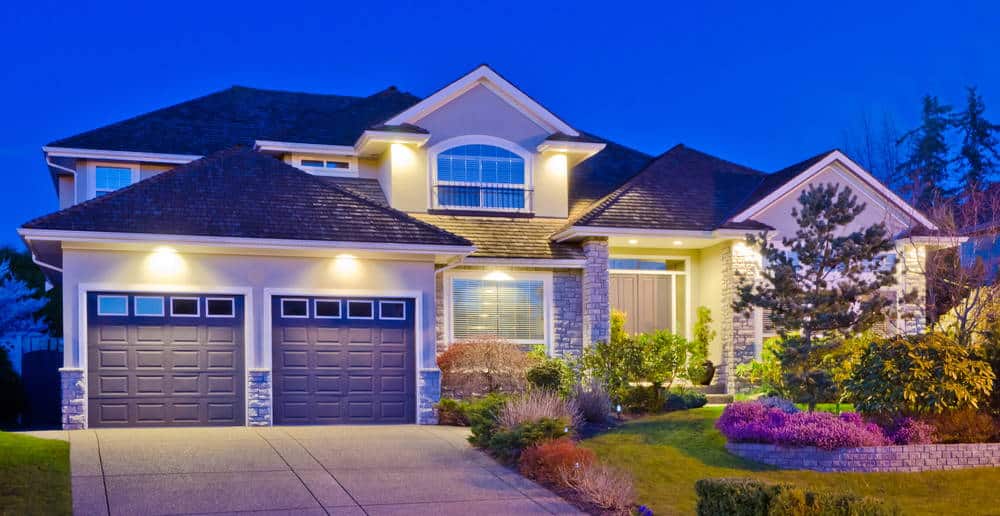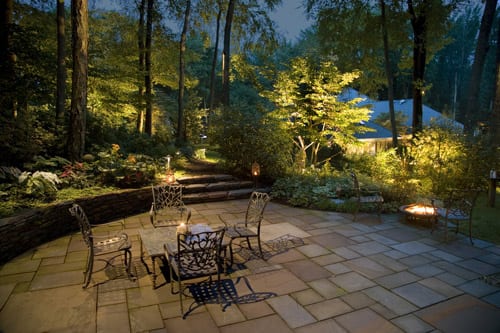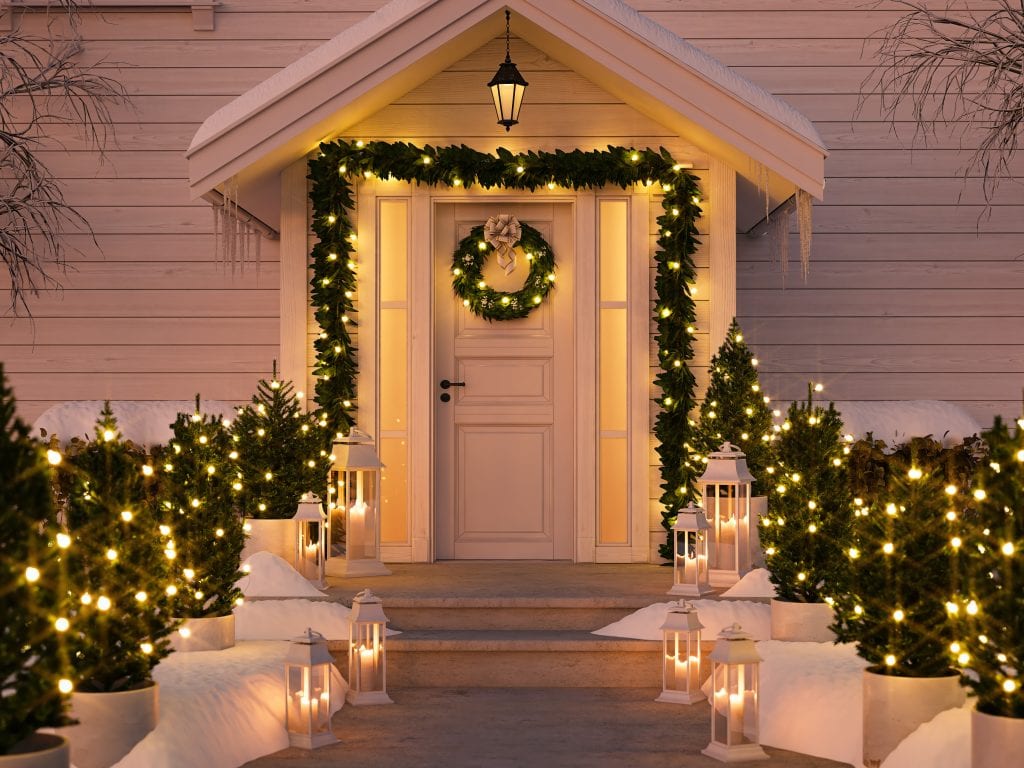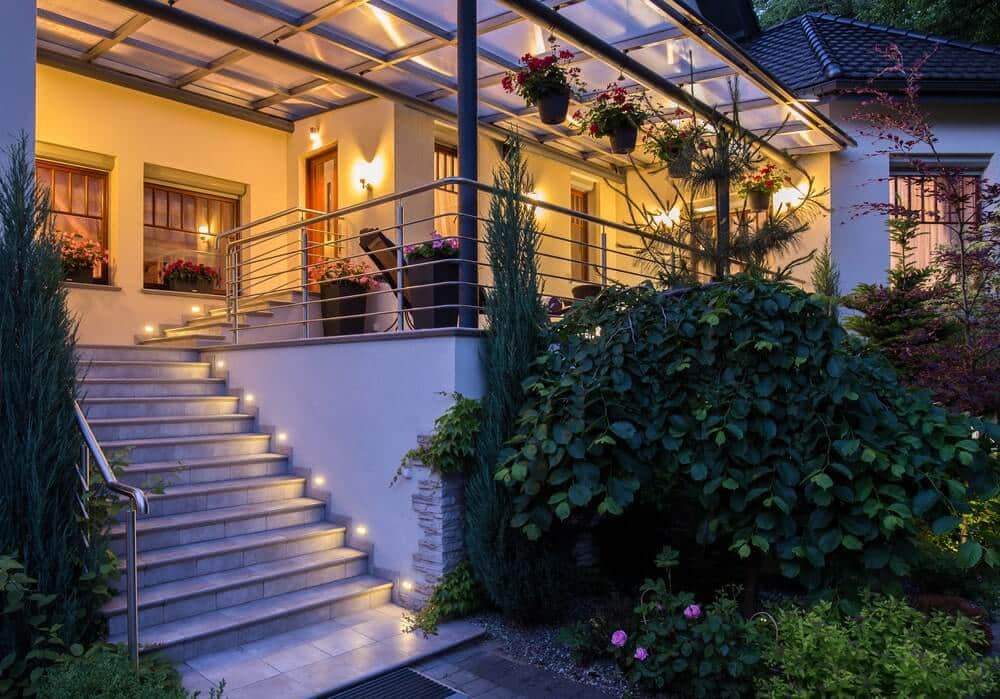The Ultimate Guide

Outdoor lighting is one of the most popular landscaping features across the country, but even more prized here in Minnesota where the days are shorter.
Traditional outdoor lighting for residential properties was limited before landscape lighting made its sparkling debut in higher end residential properties, thanks to Frank B. Nightingale’s, the Father of Garden Lighting. His 120 V fixtures were expensive and a bit bulky, but they paved the way for future innovations.
In the early sixties, low-voltage landscape lighting as it is commonly used today was born. Bill Locklin was an electrical contractor who experimented with low-voltage lighting projects for friends and neighbors. His efforts were driven by the motto, ” See the effect and not the source.”
It wasn’t until he completed a project for a friend who was expecting special guests, Dwight and Mamie Eisenhower, that Locklin realized he was onto something. The president first hired him to install lighting at his vacation retreat. Later, Bill Locklin and his newly founded company, Nightscaping®, was installing this energy efficient lighting on the grounds of the White House.
As recently as the early 90s, Nightscaping® was the leading supplier of outdoor lighting fixtures and components. Their products were understated in design, simple in construction, and reliable in their performance. Nowadays, landscape lighting fixtures are part of the daytime design as much as they are the nighttime effect.
Outdoor lighting promises to enhance and extend the utility of your outdoor environment, making it safer, more intimate, and visually stunning. It enhances the lifestyles of Minnesota homeowners every evening as the setting sun cues its performance. It’s also a popular complement to traditional lighting for seasonal and special events, such as birthdays, weddings, Christmas, and Halloween.
This guide will incorporate an outdoor lighting system into your outdoor living spaces with tips and advice to simplify its planning and design.
Scroll down to find the full table of contents.
Outdoor Lighting Planning and Design
A great way to get started with outdoor lighting is by becoming aware of how it is used in places that you frequent. Take notice of how restaurants, hotels, parks, and neighboring homes are lighted. Make note of what you like, the types of fixtures, uplighting and downlighting trees, and the use of lighting to create on walls, lawns, pools, and paved surfaces.
Commercial properties mostly use hardwired 120V lighting for its durability and resistance to vandalism. Whereas many other venues use the same affordable low-voltage lighting is readily available and appropriate for your home.
You may be wondering if it is best to design for outdoor lighting from the beginning, when you are working through your initial landscape design plan. This is an important time to plan for installing access into walls, under patios and driveways, and anywhere else that makes sense to avoid future rework. This aspect of planning will be easier if you have previous experience with landscape lighting.
Work with a designer who understands lighting design and installation. Take the time to visit properties that they have previously designed. If necessary, ask to have a transformer and sampling of lights set up at your home to see them in action before making final decisions. This is especially helpful if you plan to use LED lighting that has many options to choose from.


Landscape Lighting Care and Troubleshooting
Outdoor lighting components are designed to withstand even harsh Minnesota winters, but you should be prepared for accidental damage too. Lawn mowers, garden spades, and curious animals can take down at least a portion of your system without notice.
If your home has an automatic lawn irrigation system, you know something can go wrong at the worst time, such as a hot weekend when your service professionals are unavailable. For this reason, you have learned to keep extra nozzles or pipe clamps handy to make repairs in a pinch.
If your landscape lighting system is inspected by lighting professionals at least annually, then you should be in good shape. This is the time to replace lamps and secure loose wire connections. When in doubt, our recommendation is to fix what may or may not need fixing, especially in hard to reach places. Considering that most low-voltage components are inexpensive, it’s best to repair them when the first signs of weakness are evident.
Like anything else in your landscaping, it’s best to have a general understanding of its operation. This allows you to communicate with service professionals to troubleshoot problems over the phone. If you don’t have one, get a plan that details your outdoor lighting system to simplify ongoing care and maintenance.
Most importantly, rest assured that industry technology has advanced to make outdoor lighting more flexible, reliable, and dramatic, with the evolution of LED lighting being one of the most significant contributors.
Christmas and Holiday Lighting Displays
Christmas and holiday lighting bring out the joy of the season. Yet, planning and setting up these displays are not without frustrating moments we can all relate to when we watch the popular films that exaggerate them to bring out the funny.
Holiday lighting displays are unique in that the style and scope run the entire range of the spectrum. Understated Christmas lighting and crafted, season decorating evoke quiet memories of intimate gatherings, often with family. An equally familiar style may involves tens of thousands of lights, illuminated figures and features, not to mention rhythmic color changes synchronized with popular holiday music.
Lighting for holidays and birthdays are often treated as a singular project. In addition to planning, there is a set up followed by a take down. In some instances, storing the lights and decorative elements is part of the project too. Whether it is hired out of self-installed, these special lighting projects can be time-consuming.
If you are already planning for outdoor lighting, it’s possible to build the capability for special events into your system. You may only occasionally use this capability, but its one-time cost is effectively reduced over time as you continue to enjoy the benefits for years to come.


Landscape Lighting Trends and Style
Outdoor lighting is experiencing a breakout in its types of applications thanks to a series of technology developments.
In addition to color, you can also manipulate the timing and brilliance of your lighting using Bluetooth technology. The days of making such adjustments on the transformer itself are coming to an end. It’s time to embrace a new era, one consisting of convenience and dependability.
Bluetooth technology boasts the ability to offer a universally compatible and secure connection without the bulky hardware of its ancestors that also required tedious operations simply to change out a burned out lamp.
Lighting areas that are not readily accessible to power has also been simplified. Now you can light your outdoor living spaces with solar lights. By the year 2030, these clean energy technologies will become standard, greatly reducing installation costs and making lighting designs more flexible too.
We hope you are inspired to take the next step toward making outdoor landscape lighting part of your outdoor living environment.
Save the link to this guide as we’ll be adding more informative articles over time.
